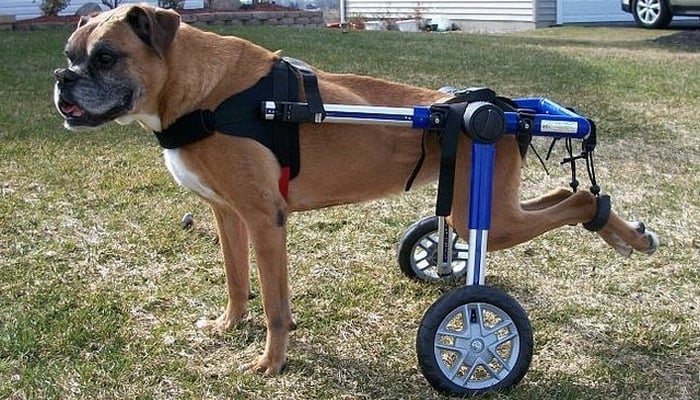 Last week I shared some resources for pet owners who are caring for a diabetic dog. When your dog gets diagnosed with a disease like diabetes, at least you know that it is manageable and with the right care you can provide your dog with a happy and healthy life. When your dog has a disability it can be hard to see the upside. It's easy to focus on the negative, but you need to remember that with the proper supplies and the right care, making life easier for a disabled dog can be done.
Last week I shared some resources for pet owners who are caring for a diabetic dog. When your dog gets diagnosed with a disease like diabetes, at least you know that it is manageable and with the right care you can provide your dog with a happy and healthy life. When your dog has a disability it can be hard to see the upside. It's easy to focus on the negative, but you need to remember that with the proper supplies and the right care, making life easier for a disabled dog can be done.
The biggest difference between pets with disabilities and humans with disabilities is that animals don't let their disability effect their disposition. They don't dwell on the negative and let their disability ruin their spirit. Your dog will still have a loving, happy personality and he'll still want to cuddle and play with you.
Your disabled dog doesn't feel sorry for himself – you do!
Take a lesson from your dog and look at his disability as a challenge, not a death sentence. I can promise you that whether you adopt a disabled puppy or welcome a disabled adult dog into your family, you're going to learn a lot from him. If you let him, your disable dog will teach you to live life to the fullest and not dwell on the things you can't change.
Making life easier for a disabled dog doesn't have to be expensive and it's not a full time job. There are many ways that you can help your disabled with inexpensive or homemade supplies. You can still work outside the home and give a disabled dog a happy life.
Making Life Easier for A Disabled Dog

dogswithdisabilities.com is an excellent resource for pet parents who are struggling with all the questions that come with caring for a disabled dog. They have information for dog owners who are new to caring for a disabled pet, pet owners who are questioning when the right time is to euthanize a disabled dog and everything in between.
This site also has pages for specific ailments including spinal problems, epilepsy, degenerative myelopathy and more. You can find tips and tricks for diapering your dog and facts and treatments for pressure sores. If you've got questions about making life easier for a disabled dog, you're likely to find the answers on this site.
The site's homepage includes some facts about dogs with disabilities that all owners should read, including:
- Are accepting of what life has to offer
- Accept as much help as their pride can take
- Take each day as it comes and smell the flowers they can reach (and sometimes eat them)
- Have more patience than we'll ever have in the same situation
- Don't worry if we love them, they know we do
- Do worry if we'll take care of their needs – and shouldn't have to
- Don't say what if, they just do what they can
handicappedpets.com is another excellent resource. The site's main focus is on dogs that require the use of a wheelchair, but they have additional resources as well. There is useful information for pet owners who have had a handicapped dog for years, and there are a lot of great resources for dog owners who are new to caring for a disabled pet.
This website is also a good resource for dog owners who believe their pet may be developing a handicap. According to the site, you should be on the lookout for these signs:
- Inability to stand up without assistance
- Difficulty going up stairs, or getting into a car
- Difficulty walking or running, limping or whining
- Uncontrolled or accidental urination, urinating in bed
- Hesitancy to walk across a slippery wooden floor
- Unusual growths on any part of the pet's body
- Change in weight, eating habits, or temperament
- Weakness due to recovery from a medical procedure
More references, videos and forums are available on capablecanines.webs.com. I'll let their mission statement speak for itself.
- To help people cope with the many challenges they face when caring for a handicapped dog, offering encouragement and assisting with adaptive devices and resources, in order to help eliminate the practice of euthanizing these special needs dogs.
The best resource you'll have when it comes to caring for a disabled dog is other pet parents who have dealt with the same struggle. Morieka Johnson wrote this blog for the Mother Nature Network that includes tips for making life easier for a disabled dog. The tips are from parents of dogs with disabilities.
- “Just because he’s paralyzed doesn’t mean there’s anything wrong with him,” says Jordi, who ends each day with a ritual scratch-fest, scratching all those spots that Scooter cannot reach alone. “Don’t be afraid to take the challenge; it will enrich your life. It’s not their fault that they are high maintenance, but don’t be afraid to take that leap. The dog isn’t.”
There are many different types of disabilities, and you'll need to research your dog's specific needs. This article by Wendy C. Brooks, DVM, discusses dogs that are paralyzed. She explains everything from how to keep your paralyzed dog clean to the physical therapy that may benefit him.
Many people don't realize that paralyzed pets can develop bed sores. There skin can also be damaged from dragging the paralyzed part of their body on the ground. Brooks discusses this issue in detail and what you can do to help your dog.
- The paralyzed pet will probably have some ability to drag himself or change positions somewhat but be aware of sores developing on pressure points. Especially vulnerable areas include: elbows, ankles, and hips. If sores develop, see your veterinarian for care. Padding or bandages for these areas may be needed.
Deafness is another common canine disability. You shouldn't write a dog off just because he can't hear. Deaf dogs are still trainable, it just takes a different approach. Deaf Dogs Rock is an excellent blog for pet parents who have or are considering adopting a deaf dog.
Christina Lee is the proud owner of a deaf dog, and she shares her experiences in some of the sites blog posts. In this post, she shares her tips for training a deaf dog.
- If you have a dog park where you live, try to visit the park with your dog at least once a week so your dog can play off leash and learn to develop relationships on his/her own without being subject to every move they make being controlled by a human. This works very well if you can get your dog to look at you often and make sure he has a good recall before you turn him loose.
According to the Deaf Dog Education Action Fund, there are many myths and misconceptions about owning a deaf dog. This article explains some of those and why they are not true. You'll find out that deaf dogs can actually be great family dogs, that they aren't the most likely dog to be hit by a car, and that deaf dogs do not need a playmate that can hear in order to be happy.
- The truth here is that deaf dogs do not need a hearing companion as a guide. They are no different from any other dog in this regard. They do perfectly well as an only dog, as part of a larger family, or with only other deaf dogs. There is no valid reason that a deaf dog cannot be placed as an only dog in a home.
Being blind is another common canine disability. Making life easier for a disabled dog may seem impossible if your pet can't see, but there are many things that you can do to help him cope with his disability. Pet Education has a great article full of tips to help your blind pet move around the house, play and be comfortable while traveling away from home.
- If your dog will be visiting a groomer or spending time at the kennel or veterinary clinic, create a sign for the cage or run door explaining his condition. If you will be traveling to a strange place, take along some familiar items like a favorite toy or blanket.
Tracy Vogel wrote a very extensive article for VetCentric's website. It discusses the differences between dogs who are born blind or lose sight at a young age and dogs who develop blindness in old age. It also gives pet parents a lot of useful tips to help make life easier for their blind dog.
- Some people will use plug-in air fresheners or scented candles in each room to help the dog develop an olfactory map of the house, Dr. Marlar said. Scented oils can help warn the dog of the presence of a wall or furniture as it approaches.
If you're the proud parent of a disabled dog, we'd love to hear from you. Please share your dog's story in the comments below. Don't forget to tell us your tips and tricks for making life easier for a disabled dog. You're suggestions may be able to help pet owners dealing with the same struggles.













